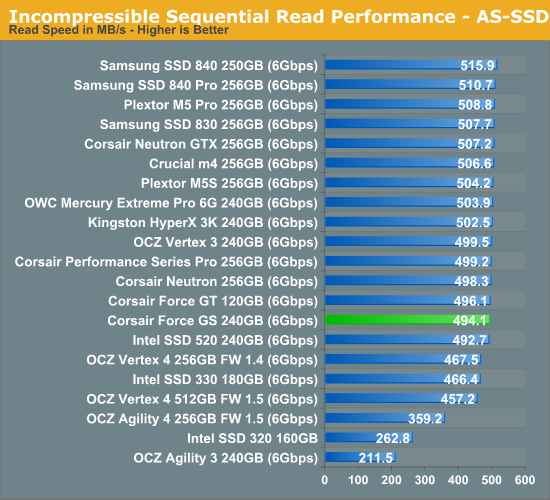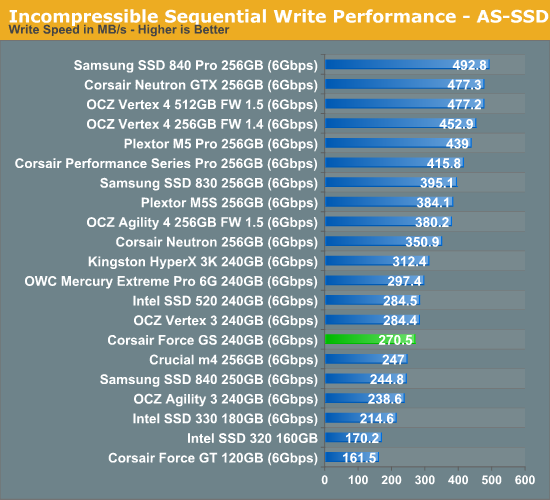SandForce TRIM Issue & Corsair Force Series GS (240GB) Review
by Kristian Vättö on November 22, 2012 1:00 PM ESTAS-SSD Incompressible Sequential Performance
The AS-SSD sequential benchmark uses incompressible data for all of its transfers. The result is a pretty big reduction in sequential write speed on SandForce based controllers, while other drives continue to work at roughly the same speed as with compressible data.


No surprises in incompressible sequential performance. Incompressible write performance is another aspect that SandForce is focusing on with their SF-3000 series; it's too early for concrete numbers but any and all improvements are welcome.










56 Comments
View All Comments
JellyRoll - Saturday, November 24, 2012 - link
Entertaining that you would link to thessdreview, which is pretty much unanimously known as the home of misinformation. Here is a link to the actual slide deck from that presentation, which does not ever mention deduplication.http://www.flashmemorysummit.com/English/Collatera...
CeriseCogburn - Saturday, December 29, 2012 - link
LOL - good job, I will continue to read and see if all the "smart" people have finally shut the H up.I was hoping one would come by, apologize, and thank you.
Of course I know better.
*Happy the consensus is NOT the final word.*
dishayu - Friday, November 23, 2012 - link
Get Kristian on to the next episode of the podcast and make him talk!!popej - Friday, November 23, 2012 - link
What exactly does it mean: "I TRIM'ed the drive after our 20 minute torture"?Shouldn't TRIM function be executed by OS all the time during torture test?
Kristian Vättö - Friday, November 23, 2012 - link
Most of our tests are run without a partition, meaning that the OS has no access to the drive. After the torture, I created a partition which formats the drive and then deleted it. Formatting the drive is the same as TRIMing all user-accessible LBAs since it basically tells the controller to get rid of all data in the drive.popej - Friday, November 23, 2012 - link
Does it mean, that there was no TRIM command executed at all?Not when torturing drive, because it wasn't TRIM supported partition. Not when you "TRIM'ed" drive, because it was a format.
While I agree that you can notice some weird effects, why do you describe them as TRIM problems? Sorry, but I don't know how your test could be relevant to standard use of SDD, when TRIM is active all the time.
Kristian Vättö - Friday, November 23, 2012 - link
Formatting is the same as issuing a TRIM command to the whole drive. If I disable TRIM and format the drive, its performance won't restore since the drive still thinks the data is in use and hence you'll have to do read-modify-write when writing to the drive.They are problems in the sense that the performance should fully restore after formatting. If it doesn't, then TRIM does not function properly. Using an extreme scenario like we do it the best for checking if there is a problem; how that affects real world usage is another question. With light usage there shouldn't be a problem but you may notice the degradation in performance if your usage is write intensive.
popej - Friday, November 23, 2012 - link
Basing on you test I would say, that format is not enough to restore drive performance after using it without TRIM. Quite possible that the state of the drive after torture without TRIM is very different to anything you can get when TRIM is active.It would be interesting to compare your test to real life scenario, with NTFS partition and working TRIM.
Kristian Vättö - Friday, November 23, 2012 - link
With most SSDs, formatting the drive will fully restore it's performance, so the behavior we're seeing here is not completely normal.Remember that even if TRIM is active at all times, sending a TRIM command to the controller does not mean the data will be erased immediately. If you're constantly writing to the SSD, the controller may not have time to do garbage collection in real time and hence the SSD may be pushed to a very fragmented state as in our test where, as we can see, TRIM doesn't work perfectly.
I know that our test may not translate to real world in most cases, but it's still a possible scenario if the drive is hammered enough.
JellyRoll - Friday, November 23, 2012 - link
If the majority of your tests are conducted without a partition that means none of the storage bench results are with TRIM?